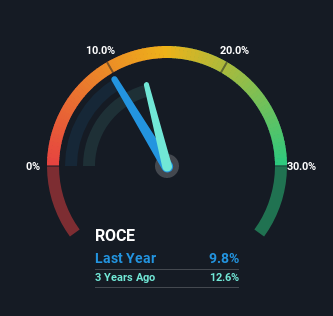- United States
- /
- Machinery
- /
- NYSE:PLOW
Returns On Capital At Douglas Dynamics (NYSE:PLOW) Have Hit The Brakes

To find a multi-bagger stock, what are the underlying trends we should look for in a business? One common approach is to try and find a company with returns on capital employed (ROCE) that are increasing, in conjunction with a growing amount of capital employed. This shows us that it's a compounding machine, able to continually reinvest its earnings back into the business and generate higher returns. Having said that, from a first glance at Douglas Dynamics (NYSE:PLOW) we aren't jumping out of our chairs at how returns are trending, but let's have a deeper look.
Understanding Return On Capital Employed (ROCE)
If you haven't worked with ROCE before, it measures the 'return' (pre-tax profit) a company generates from capital employed in its business. The formula for this calculation on Douglas Dynamics is:
Return on Capital Employed = Earnings Before Interest and Tax (EBIT) ÷ (Total Assets - Current Liabilities)
0.098 = US$47m ÷ (US$613m - US$129m) (Based on the trailing twelve months to June 2022).
Therefore, Douglas Dynamics has an ROCE of 9.8%. Even though it's in line with the industry average of 10%, it's still a low return by itself.
See our latest analysis for Douglas Dynamics

Above you can see how the current ROCE for Douglas Dynamics compares to its prior returns on capital, but there's only so much you can tell from the past. If you'd like, you can check out the forecasts from the analysts covering Douglas Dynamics here for free.
What Does the ROCE Trend For Douglas Dynamics Tell Us?
We've noticed that although returns on capital are flat over the last five years, the amount of capital employed in the business has fallen 21% in that same period. When a company effectively decreases its assets base, it's not usually a sign to be optimistic on that company. Not only that, but the low returns on this capital mentioned earlier would leave most investors unimpressed.
Another point to note, we noticed the company has increased current liabilities over the last five years. This is intriguing because if current liabilities hadn't increased to 21% of total assets, this reported ROCE would probably be less than9.8% because total capital employed would be higher.The 9.8% ROCE could be even lower if current liabilities weren't 21% of total assets, because the the formula would show a larger base of total capital employed. So while current liabilities isn't high right now, keep an eye out in case it increases further, because this can introduce some elements of risk.
What We Can Learn From Douglas Dynamics' ROCE
In summary, Douglas Dynamics isn't reinvesting funds back into the business and returns aren't growing. And investors appear hesitant that the trends will pick up because the stock has fallen 13% in the last five years. On the whole, we aren't too inspired by the underlying trends and we think there may be better chances of finding a multi-bagger elsewhere.
Douglas Dynamics does have some risks, we noticed 3 warning signs (and 2 which are significant) we think you should know about.
For those who like to invest in solid companies, check out this free list of companies with solid balance sheets and high returns on equity.
New: Manage All Your Stock Portfolios in One Place
We've created the ultimate portfolio companion for stock investors, and it's free.
• Connect an unlimited number of Portfolios and see your total in one currency
• Be alerted to new Warning Signs or Risks via email or mobile
• Track the Fair Value of your stocks
Have feedback on this article? Concerned about the content? Get in touch with us directly. Alternatively, email editorial-team (at) simplywallst.com.
This article by Simply Wall St is general in nature. We provide commentary based on historical data and analyst forecasts only using an unbiased methodology and our articles are not intended to be financial advice. It does not constitute a recommendation to buy or sell any stock, and does not take account of your objectives, or your financial situation. We aim to bring you long-term focused analysis driven by fundamental data. Note that our analysis may not factor in the latest price-sensitive company announcements or qualitative material. Simply Wall St has no position in any stocks mentioned.
About NYSE:PLOW
Douglas Dynamics
Operates as a manufacturer and upfitter of commercial work truck attachments and equipment in North America.
6 star dividend payer with solid track record.
Similar Companies
Market Insights
Community Narratives




